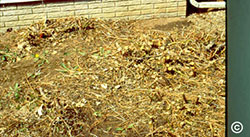Why isn’t my shrub flowering?
With time, and in some locations, lilac flowering may decrease. But before you take drastic measures, consider all the potential reasons your lilacs aren’t flowering. For example, a late freeze may eliminate flowers for one season. Shade from new buildings and maturing trees also limits bloom. Plants need at least five hours of sunshine daily to bloom well, so you may need to thin overhead trees to let in more light. Fertilizer is rarely the answer for a plant that once bloomed well.
How does renewal pruning help?
 Renewal pruning solves the problem of decreased bloom, as well as problems caused by oyster shell scale and borer insect buildup. Remove the oldest, thickest stems at the base to prune away insect problems. The remaining young stems will grow and produce the desired blooms. January to mid-March is the best time to prune.
Renewal pruning solves the problem of decreased bloom, as well as problems caused by oyster shell scale and borer insect buildup. Remove the oldest, thickest stems at the base to prune away insect problems. The remaining young stems will grow and produce the desired blooms. January to mid-March is the best time to prune.
Consider removing one-third of the older stems this year, another third the following year, and the remaining third the next year. This is the best way to maintain lilacs and many other shrubs. This method produces a better looking shrub than tip pruning alone, which should be done only to shape the shrub.
What is rejuvenation pruning?
Older, overgrown lilacs may require drastic rejuvenation pruning, which means cutting off every stem four inches above the ground. Resilient lilacs will grow two to three feet the first season.
Thinning stems so that only a few healthy ones remain eliminates competition among them. From then on, yearly renewal pruning will keep your lilac blooming.
For more information, see the following Planttalk Colorado™ video(s).
For more information, see the following Colorado State University Extension fact sheet(s).



